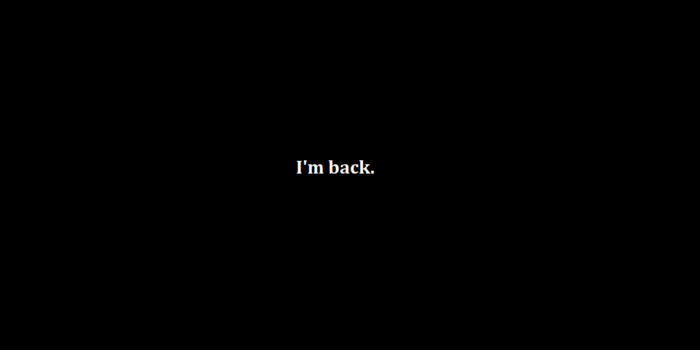Hello again.
It’s taken me almost three months to get over the hefty fine that was slapped on me for misusing an image on this blog. I did a lot of sulking and soul searching, all while reading an abundance of horror novels and watching countless hours of RuPaul’s Drag Race. Plus I moved home, got civil partnered and started a dog behaviour course (step aside, Cesar Millan). Suffice to say it’s been a very eventful 2021 thus far.
But while it has been eventful, I’m feeling a bit frustrated with myself. What started off as a necessary break from writing outside of my day job quickly turned into an excuse – I wasn’t writing, or thinking about writing, because I was ‘being kind to myself’. I wasn’t challenging myself or starting any new projects because I was ‘focusing on my wellbeing’. I was ignoring emails and any opportunities that came my way because I needed more ‘me time’.
While I definitely needed to be kinder to myself and focus on my wellbeing and have more me time, I was using those same excuses to not eat healthily or exercise. I was basically permitting myself to be lazy with buzzwords. I was coasting, and when I realised I was bored and unhappy I knew it was time to get back to writing. Because surely you can’t be bored and unhappy if you’re looking after yourself?
Long story short, I got the itch to write again. Being a writer is like having herpes – it never truly goes away.
So today I decided to open up my Dystopic inbox for the first time in months. After wading through an obscene amount of junk mail, I found an exciting message from Jeffery Zavadil about his latest novel.
Jeffery has been kind enough to provide Dystopic with excerpts of the first and second novels in his dystopian Mallworld series, and now I’m delighted to be able to share an excerpt from his third novel, Mallworld, Inc: Bound Forward.
In Bound Forward, things are really starting to amp up for the Rebound Party. This series dissects democracy, capitalism, media and class and is a must for lovers of the political intricacies of Nineteen Eighty-Four.
A big thank you to Jeffery for making my return to Dystopic so rewarding. It’s good to be back.
Enjoy the excerpt.

Jime stared out the window of the tram he was riding as it carried him and other passengers through the wide belt of foliage that now ringed the old Mall. He was reminded of how much had been regrown and rebuilt in the last generation. Where once only desert had surrounded the Mall, fields and forests now flourished. This was known as the Green. It would take decades for humanity to fully reseed and replant the biosphere and for Mother Nature, with a nudge from science, to recover at deep ecological levels. But they were off to a good start. Early in the trip, the tram passed an ecorecovery crew of botanists and agriculturalists reviving a bare patch of earth, which was already half-planted with genetically engineered grasses, bushes, and trees of all kinds. This diversity was meant to blossom into wildland in less than a decade, once animals were reintroduced. Ecorecovery was started by cleaning up red sludge and other toxins and reintroducing flora and fauna that had once been native to the area. Humans then got out of the way and let natural processes reestablish an equilibrium. Advances in genetics and the biological sciences had allowed for environmental resurrection. Mallworld Institute of Technology’s digital DNA archive of ancient flora and fauna allowed regrowth of ecosystems through cloning techniques. One key piece of luck that also boosted ecorecovery efforts was the rediscovery of a pre-Mall vault of plant and animal samples, in many cases genetic samples but in others fully preserved organisms, that scientists had sequestered in the early days of the environmental crisis. This was leading to a much more biodiverse ecorecovery. Tragically, nature would never truly be restored to the same level of biodiversity it had before capitalism. Nonetheless, when the ecorecovery process had run its course, the biome would at least be close to what it had been at the dawn of the industrial age. Jime looked to the horizon, where the partly dismantled Mall still stood, still some twenty-five miles away; in between, there was Green everywhere. While villages and towns now extended around the Mall, their buildings poking up above the trees, great care had been taken to space them widely to allow for the regrowth of forests, grasslands, and wetlands. There were farms and orchards, too, but many of the renewed areas were intentionally left wild, off-limits to humans once they were grown, with access restricted to scientists and ecologists only. Animal populations had also been restored throughout the Green, and a new ecological homeostasis was emerging. It was estimated that it would take a little more than a century to restore the North American bioregion. The Dismantling Plan for the Mall would take about as long… As the tram got closer to the remnants of the Mall, the density of buildings and other structures increased, as one would expect. No longer the hermetically sealed structure it once was, the Mallwall was gone, and the edges of the Mall now blended into the Green. Its geographic footprint had shrunk by some 20 percent already. But while the majority of the buildings and structures of the Mall interior still existed, many roof sections and even whole domes had been taken down, and it looked more like a traditional city and less like the giant shopping center it had once been. This great uncovering was motivated both by a growing desire to reconnect with nature and by the memory of the Piazza Plaza collapse. It was a city now integrating with nature, with real trees and plants spread out seamlessly from the Green into Mall streets and passages. As Jime’s tram approached the terminal near the convention center where he would give his speech, he observed parks, forums, fountains, and community houses where old plastic storefronts had once been. Instead of workers and businesspeople rushing relentlessly about, he saw a teacher leading a class of children in an outdoor lesson; a group of artists with easels making charcoal drawings; families relaxing with picnics in a grassy park; condo cohousing residents painting a mural together on the side of their building; a troupe of actors giving a public performance in a square with a large audience; and what looked like a village-sized public assembly in an outdoor amphitheater. There was a pluralism of activities, not just working and shopping. Jime smiled with satisfaction.




Leave a Reply